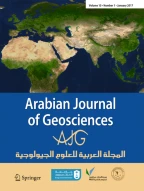Abstract
The stability problem of natural slopes, filled slopes, and cut slopes are commonly encountered in Civil Engineering Projects. Predicting the slope stability is an everyday task for geotechnical engineers. In this paper, a study has been done to predict the factor of safety (FOS) of the slopes using multiple linear regression (MLR) and artificial neural network (ANN). A total of 200 cases with different geometric and shear strength parameters were analyzed by using the well-known slope stability methods like Fellenius method, Bishop’s method, Janbu method, and Morgenstern and Price method. The FOS values obtained by these slope stability methods were used to develop the prediction models using MLR and ANN. Further, a few case studies have been done along the Jorabat-Shillong Expressway (NH-40) in India, using the finite element method (FEM). The output values of FEM were compared with the developed prediction models to find the best prediction model and the results were discussed.
Similar content being viewed by others
References
Ahangar-Asr A, Faramarzi A, Javadi AA (2010) A new approach for prediction of the stability of soil and rock slopes. Eng Comput 27(7):878–893
Beale R, Jackson T (1990) Neural computing: an introduction. Institute of Publishing, Bristol
Chae BG, Lee JH, Park HJ, Choi J (2015) A method for predicting the factor of safety of an infinite slope based on the depth ratio of the wetting front induced by rainfall infiltration. Nat Hazards Earth Syst Sci 15:1835–1849
McClelland T. L., Rumelhart D. E., and the PDP Research Group (1986) Parallel distributed processing. Cambridge: The MIT Press
Demuth H, Beale M (1995) Neural network toolbox for use with MATLAB. The Math Works Inc., Natick
Erzin Y, Cetin T (2012) The use of neural networks for the prediction of the critical factor of safety of an artificial slope subjected to earthquake forces. Scientia Iranica 19(2):188–194
Firmansyah, Feranie, S., Tohari, A. and Latief, F. D. E. (2016) Prediction of landslide run-out distance based on slope stability analysis and center of mass approach. IOP Conf Ser: Earth Environ Sci 29
Gupta MM, Jin L, Homma N (2003) Static and dynamic neural network. Wiley, New York
Hoek E, Bray JW (1981) Rock slope engineering. Institution of Mining and Metallurgy, London
Kayesa, G. (2006). Prediction of slope failure at Letlhakane mine with the Geomos slope monitoring system. Int Sympos Stabil Rock Slopes Open Pit Min Civ Eng 605–622
Maier HR, Dandy GC (2000) Neural networks for the prediction and forecasting of water resources variables: a review of modeling issues and applications. Environ Model Softw 15(2000):101–124
MATLAB (R2011a). Neural Network Toolbox- User's Guide. https://in.mathworks.com/help/docarchives.html
Mohamed T, Kasa A, Mukhlisin M (2012a) Prediction of slope stability using statistical method and fuzzy logic. Online J Sci Technol 2(4):68–73
Mohamed T, Kasa A, Taha MR (2012b) Fuzzy logic system for slope stability prediction. Int J Adv Sci Eng Inform Technol 2(2):38–42
Pradhan B (2010a) Remote sensing and GIS-based landslide hazard analysis and cross-validation using multivariate logistic regression model on three test areas in Malaysia. Adv Space Res 45(10):1244–1256
Pradhan B (2010b) Landslide susceptibility mapping of a catchment area using frequency ratio, fuzzy logic and multivariate logistic regression approaches. J Ind Soc Remote Sens 38:301–320
Rumelhart DE, Hinton GE, William s R. J. (1986) Learning internal representations by error propagation. Parallel Data Processing, MIT Press, Cambridge, pp 318–362
Sakellariou MG, Ferentinou MD (2001) GIS-based estimation of slope stability. Nat Hazard Rev 2:12–21
Sakellariou MG, Ferentinou MD (2005) A study of slope stability prediction using neural networks. Geotech Geol Eng 23(4):419–445
Smith GN (1986) Probability and statistics in civil engineering: an introduction, Collins, London. Nichols Pub. Co, New York
Stone M (1974) Cross-validatory choice and assessment of statistical predictions. J R Stat Soc, B 36:111–147
Yilmaz I, Yuksek AG (2008) An example of artificial neural network application for indirect estimation of rock parameters. Int J Rock Mech Rock Eng 41(5):781–795
Author information
Authors and Affiliations
Corresponding author
Rights and permissions
About this article
Cite this article
Chakraborty, A., Goswami, D. Prediction of slope stability using multiple linear regression (MLR) and artificial neural network (ANN). Arab J Geosci 10, 385 (2017). https://doi.org/10.1007/s12517-017-3167-x
Received:
Accepted:
Published:
DOI: https://doi.org/10.1007/s12517-017-3167-x
